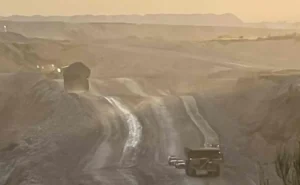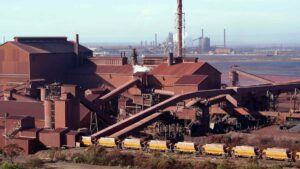The defeat of the Tiwi Islanders’ case against Santos’ Barossa gas project comes just as federal Labor is under renewed pressure to set an ambitious 2030 target emissions reduction.
The $5.8 billion project in the Timor Sea is again back on track to start production in late 2025, after a federal court dismissed a legal challenge this week.
Justice Natalie Charlesworth also lifted a temporary injunction following a challenge by a group of Tiwi Islanders, who said Santos had not properly assessed marine cultural heritage along the route of its Barossa export pipeline.
The decision clearing the way for the Barossa carbon bomb is a blow to the global effort to rein in dangerous global warming, in the wake of the world’s hottest year yet.
Gas from the Barossa project is more than double the current average Australian emissions intensity due to a high reservoir CO2 content of 18 per cent.
As a result, if Santos doesn’t take any abatement action such as carbon capture and storage, the project will require slightly more than 13 per cent of all carbon credits available in Australia in 2030, according to estimates by carbon advisory Reptuex.
In the first five years of operation it will generate around 19 MtCO2-e of gross emissions, reaching around 4 MtCO2-e per annum by the end of the decade.
An analysis by the Australia Institute last year suggested those five years will cost Santos from $500 million to abate those emissions.
According to RepuTex, the Barossa project alongside expansions to the Pluto LNG plant and the addition of the Browse gas field will account for three quarters of new emissions under the Safeguard Mechanism.
Climate Energy Finance director Tim Buckley says that shows just how emissions intensive oil and gas projects are, but also indicates a lack of industrialisation in Australia.
“Barossa is a carbon factory with LNG as a byproduct,” he says.
“But when we talk about Scope 1 emissions facilities of more than 100,000 mtCO2e/year, we don’t have a lot of them because Australia is a ‘dig and ship’ country. The majority of these facilities are fossil fuel exports anyway.”
Teals, Greens could force emissions standards to tighten
Meanwhile, Teal MPs in Sydney, Melbourne and Perth are planning to demand a 75 per cent reduction in national emissions by 2035 as a condition of their support for the Albanese government in the 2025 election.
The current government has a one-seat majority and teals make up six of the 18 crossbench seats.
The Greens, which made no new gas or coal their starting point in negotiations over the Safeguard Mechanism in 2023, are bound to apply their own pressure on emissions.
If Labor struggles to win a majority and is forced into negotiations, a stark reduction in emissions – even if not 75 per cent – could be on the cards.
It might also finally make climate a real factor in ministerial decision making around environmental approvals, rather than local groups needing to resort to complex court challenges.
Four out of five major projects blocked by the Morrison and Albanese governments since 2019 as “clearly unacceptable” on environmental grounds have been renewable projects, not fossil fuel projects, says Australian Conservation Foundation CEO Kelly O’Shanassy in a LinkedIn post.
“Minister Tanya Plibersek was right to knock back the [Port of Hastings] renewable infrastructure proposal because it would forever damage threatened species and a wetland of global importance. It’s ironic, deeply distressing and vastly irresponsible that coal and gas projects are being approved at the same time,” she says.
“It is beyond time for mandatory assessment of climate impacts from proposed new projects.”
In October 2023, the federal court also rejected a legal challenge on the grounds of climate change against Environment Minister Tanya Plibersek’s approval of two coal projects in central Queensland.
Safeguard fixes some of Barossa carbon bomb, not all
The reformed Safeguard Mechanism means new emissions from the likes of Barossa must be avoided, through technology such as carbon capture and storage, or abated with carbon credits from day one. No reservoir emissions are allowed.
Furthermore, it also sets a carbon budget of 1,233 million tonnes of CO2e between 2020 and 2030 for newly approved projects.
Barossa has already been allowed for under that budget, says Reputex associated director of research Dr Anton Firth.
“We know there is an allowance for new entrants written into the budget. The fact that Barossa is included in the government’s emissions projections would imply that they have accounted for it as one of the new entrants in the Safeguard Mechanism design,” he says.
“They haven’t explicitly named Barossa, but the numbers seem to add up.”
Aside from the carbon impact, the Barossa gas project is set to have a huge impact on the environment as it is – and on the quality of life of Tiwi Islanders.
“Drilling production wells in the Barossa field will have a huge impact on marine life in the Timor Sea because it means two years of non-stop heavy industrial shipping activity and huge volumes of chemicals, cement and waste dumped into the sea during the drilling process,” Environment Centre NT campaigner Jason Fowler told RenewEconomy in 2022.
“Santos have rejected key safety measures such as locating oil spill clean up equipment at Port Melville on the nearby Tiwi Islands, ceasing drilling during cyclone season and ruling out the mandatory use of double hulled ships. This all adds up to increased risk to Tiwi Islanders who will have limited ability to react if an oil spill occurs.”










